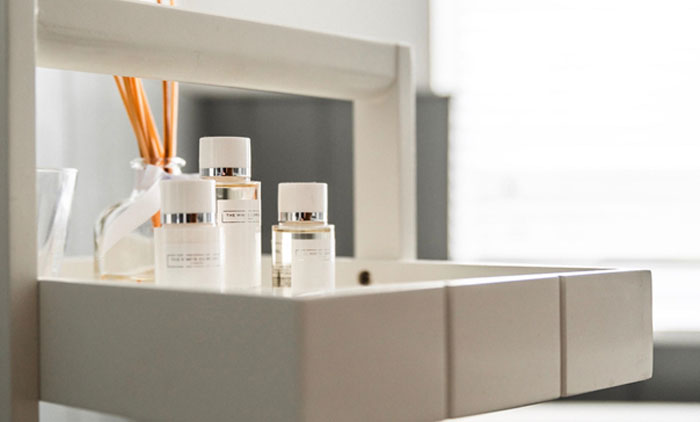Lotion is a fascinating thing because sometimes people aren’t entirely sure how it’s made. Most people think it’s hard to make since big companies employ cosmetic chemists to put it all together. The perception is that it’s not something people can make from scratch. However, ask anyone that makes the stuff and they’ll tell you this isn’t the case. In fact, it can be a surprise how simple the process of making lotion can get.

Source: https://unsplash.com/photos/g-XGxq1ELAo
At the most basic level, a lotion is a combination of water, oil, something to emulsify the mixture, and a preservative. This simple combination can get you either a lotion or a cream, depending on your specific components. Let’s take a more in-depth look at this process.
The Ingredients
First, let’s look at the ingredients.
Water
You need water. The amount of water you need will vary based on what you want to make. Lower levels of water results in something that has a thicker product, making a cream. Higher levels will create something smoother and thinner, resulting in lotion.
Oil

Source: https://unsplash.com/photos/UaO58q6ioxI
Oil can be any butter, from something cheap like soybean to something luxurious like hemp or argan. Some of these are more expensive per pound than others, but the price doesn’t always mean it’s right for you. Hemp oil has different properties from coconut oil, which in turn works differently from soybean-based oils. Read up on which oils do what, so you can pick the right one for your formula.
Emulsifier
Finally, you need an emulsifier. An emulsion mixer machine might come in handy, as well. An emulsifier is a compound you use to make the water and oil combine because by default these two don’t mix. Without emulsion, the water and oil will separate all over again and you won’t get the lotion. You need an emulsifier to make the two components bind in the right places, or you’re going to have a chemical mess.
Preservative
Finally, there is the preservative. Anything that has a lot of water content will be a breeding ground for nasty microbes, which shorten the shelf life of the product you’ve made. A preservative counters this, allowing your lotion to stay usable for longer. Anything claiming to be “all natural” and not having any preservatives is lying because those would go bad long before they got to store shelves.
The Test Batch
Once a formula is ready, a test batch comes next. This is for multiple purposes, including making sure you have the chemicals in the right proportions. Other details to test include pH balance, any side effects it may have on the skin, any allergic reactions it might cause, and even how consistent the “feel” of it is on the skin. This stage also lets you make adjustments until you get the formula right.
Manufacturing Process
With a formula confirmed, what comes after is the production itself. Industrial machinery will put together the final compound, with strict adherence to the instructions to make sure that everything is done according to plan. Most of the process is automated but will require personnel present to oversee things and make sure the machines are operating according to instructions.
Testing the Batch
The compounding process will produce a batch, which will then need quality testing. A small sample is all that is required. This part of the process involves looking into the chemical composition to see if it’s correct and if it has any impurities. It is also meant to detect any issues that will require correcting, such as water levels, pH balance, and consistency of color.
Correcting Errors
Any errors detected will be corrected. Acids and bases can be added to correct the pH balance. Water can be poured in as needed. Every batch has to fit the specifications set at the start before it can move on to filling bottles and getting shipped out. In extreme cases, it might come down to discarding the batch if it deviates too much from the base formula and no amount of correcting will make it fall in line.
Final Additions
If a batch passes the quality standards, many companies will take the opportunity to put another additive into the mix. Essential oils and fragrances are the most likely since most other ingredients don’t add a scent to the mixture. Dyes might also be added at this point, to make sure it as a pleasing appearance to go with the smell and effects.
Filling Bottles
After everything has been added, the machines prepare to pour the batch into the bottles. This takes place on a conveyor belt, which is programmed to move once a pre-set time has passed. During that time, a predetermined amount of the batch is used to fill the containers. This automated process usually has a few personnel checking to make sure there are no mechanical errors and to conduct inspections for quality.
Conclusion
Above are the typical steps involved in manufacturing lotion. You don’t necessarily need a biochemistry degree to make lotion. There are basic ingredients involved, but you can use industrial equipment and chemicals to add special touches.


Comment Policy
Your words are your own, so be nice and helpful if you can. Please, only use your REAL NAME, not your business name or keywords. Using business name or keywords instead of your real name will lead to the comment being deleted. Anonymous commenting is not allowed either. Limit the amount of links submitted in your comment. We accept clean XHTML in comments, but don't overdo it please. You can wrap code in [lang-name][/lang-name] tags.